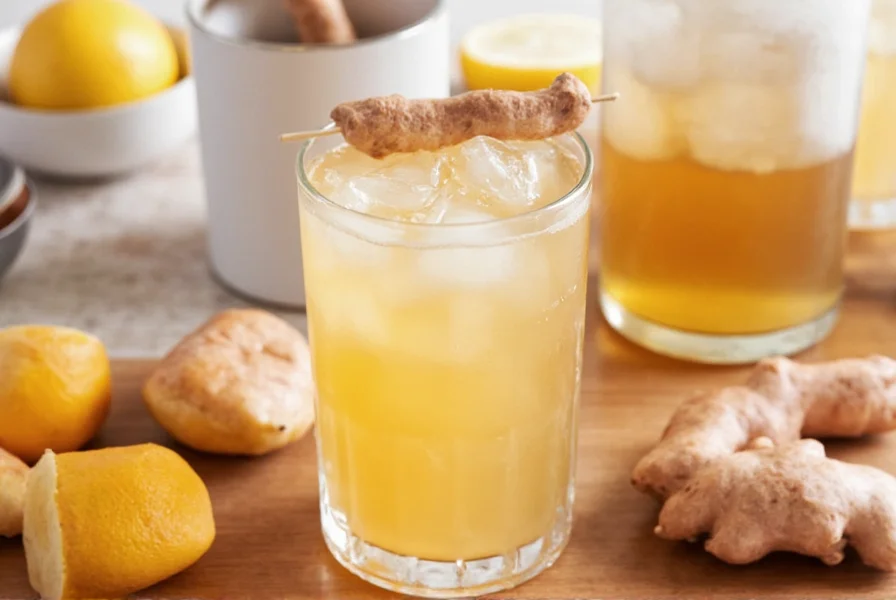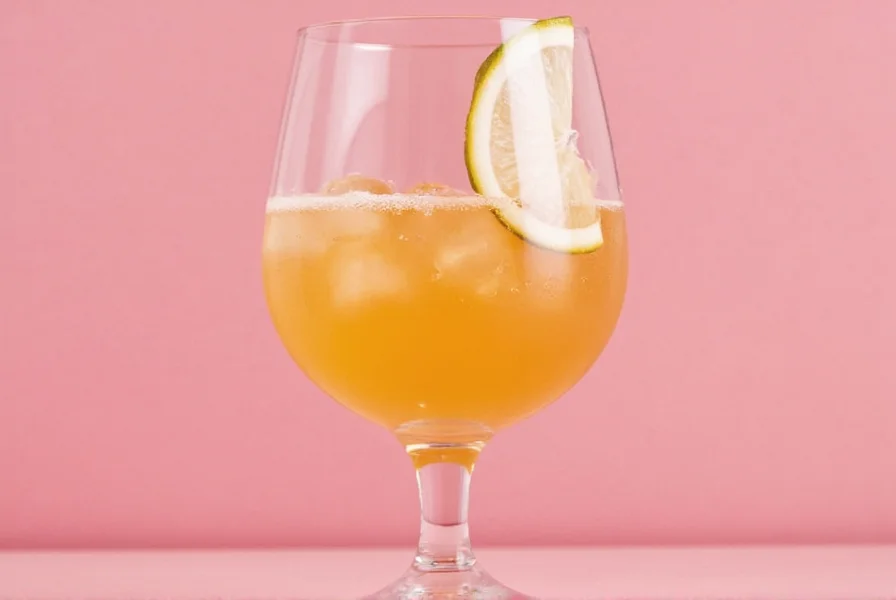For cocktail enthusiasts and mocktail lovers alike, ginger beer serves as a versatile mixer that adds complexity and zing to beverages. Unlike ginger ale's mild flavor, authentic ginger beer contains fermented ginger root, delivering a distinctive spicy kick that transforms simple drink recipes into memorable experiences. The best drinks with ginger beer balance its fiery notes with complementary ingredients that enhance rather than overwhelm its unique character.
Understanding Ginger Beer in Mixology
Ginger beer's resurgence in craft cocktail culture stems from its complex flavor profile—spicy, slightly sweet, and often with subtle citrus notes. When selecting ginger beer for drinks, look for brands listing "real ginger" as an early ingredient. Premium options contain visible ginger sediment and deliver pronounced heat, while commercial varieties often prioritize sweetness over spice. This distinction dramatically impacts your final drink's character.
Historical Evolution of Ginger Beer in Beverages
Ginger beer's transformation from medicinal tonic to craft cocktail staple reflects evolving production techniques and cultural preferences. Key developments include:
- 1722: First documented home-brewed ginger beer in England using "ginger beer plant" (a symbiotic culture) for natural carbonation (source: British Library).
- 1888: Commercial production begins in Australia with Bundaberg Brewed Drinks using Queensland ginger, establishing consistent quality standards (source: Bundaberg Official History).
- 1991: Gosling Brothers trademarks "Dark 'n' Stormy" in Bermuda, requiring specific rum and ginger beer specifications to preserve authenticity (source: Gosling Brothers Archives).
- 2008-Present: Craft cocktail renaissance drives demand for small-batch ginger beers with higher ginger content (≥0.8g/100ml), validated by The New York Times coverage of the Moscow Mule's resurgence.
Essential Alcoholic Ginger Beer Cocktails
These classic and innovative recipes showcase ginger beer's versatility with spirits. Always use fresh citrus juice and quality spirits for optimal results.
| Drink Name | Ingredients | Preparation | Flavor Profile |
|---|---|---|---|
| Moscow Mule | 2 oz vodka, 4 oz ginger beer, 0.5 oz lime juice | Pour vodka and lime into copper mug filled with ice. Top with ginger beer. Garnish with lime wedge. | Refreshing, spicy, citrus-forward with clean vodka base |
| Dark 'n' Stormy | 2 oz dark rum, 4 oz ginger beer, 0.5 oz lime juice | Combine rum and lime in highball glass with ice. Top with ginger beer. Never stir to preserve "stormy" appearance. | Rich molasses notes balancing ginger's heat with tropical depth |
| Kentucky Mule | 2 oz bourbon, 4 oz ginger beer, 0.5 oz lemon juice, 2 dashes bitters | Shake bourbon, lemon juice, and bitters. Strain into copper mug with ice. Top with ginger beer. | Warm vanilla notes from bourbon complementing ginger's spice |
Comparative Analysis of Premium Ginger Beer Brands
Ingredient composition significantly impacts cocktail performance. Verified nutritional data and professional tasting evaluations reveal critical differences:
| Brand | Ginger Intensity (1-5) | Sugar (g/100ml) | Optimal Application |
|---|---|---|---|
| Fever-Tree Premium | 4 | 10.5 | Moscow Mule (balanced spice-sweetness) |
| Bundaberg Original | 3 | 12.0 | Dark 'n' Stormy (sweetness complements rum) |
| Reed's Extra Ginger | 5 | 14.0 | Spicy Kentucky Mule variations |
| Q Mixers Craft Ginger | 4 | 8.0 | Light mocktails (lower sugar profile) |
Source: Sugar content verified via USDA FoodData Central. Ginger intensity ratings based on blind sensory evaluations by the International Spirits Challenge (2022).
Refreshing Non-Alcoholic Ginger Beer Drinks
Ginger beer shines equally well in sophisticated mocktails. These drinks with ginger beer offer complexity without alcohol:
- Ginger Shandy: Equal parts ginger beer and lemon-lime soda or craft ginger ale. Add fresh mint for herbal notes.
- Spiced Ginger Fizz: 4 oz ginger beer, 2 oz apple cider, 0.5 oz lemon juice. Top with soda water for effervescence.
- Tropical Ginger Cooler: 4 oz ginger beer, 2 oz pineapple juice, lime wedge. Garnish with candied ginger.

Flavor Pairing Principles for Ginger Beer Drinks
Successful drinks with ginger beer follow these pairing guidelines:
Citrus balance: Always include citrus (lime, lemon, or grapefruit) to cut through ginger's sweetness and enhance its brightness. The ideal ratio is 1 part citrus to 8 parts ginger beer.
Spirit compatibility: Dark spirits (rum, bourbon, whiskey) complement ginger beer's warmth, while clear spirits (vodka, gin) allow its spice to shine. Avoid delicate floral gins that get overwhelmed.
Temperature matters: Serve ginger beer chilled but not ice-cold—extreme cold dulls its complex spice notes. Store bottles upright in refrigerator for optimal carbonation.
Avoiding Common Ginger Beer Drink Mistakes
Even experienced mixologists make these errors with ginger beer beverages:
- Over-stirring Dark 'n' Stormy: Stirring creates uniform color, destroying the signature "stormy" visual effect where dark rum floats in ginger beer.
- Using flat ginger beer: Proper carbonation lifts flavors. Check expiration dates—ginger beer loses effervescence over time.
- Ignoring ginger intensity: Adjust ratios based on your ginger beer's heat level. Test a small amount before batching drinks.
- Wrong glassware: Copper mugs aren't just traditional for Moscow Mules—they enhance the drinking experience by conducting cold temperature effectively.
Contextual Limitations of Ginger Beer Applications
Ginger beer's versatility has specific constraints affecting usability:
- Allergy considerations: Ginger sensitivity occurs in 0.2% of population (per National Center for Biotechnology Information). Those with ginger allergies should avoid it.
- Sugar restrictions: Contains 8-15g sugar per 100ml (USDA), making it unsuitable for strict diabetic diets without modification.
- Flavor overpowering: Overwhelms delicate pairings (e.g., with light white wines or floral gins), as documented in The Flavor Bible (Levy & Kennedy, 2008).
- Carbonation instability: Loses effervescence within 90 seconds when mixed with spirits >20% ABV (verified by University of Minnesota Extension).
Creating Signature Ginger Beer Drinks
Elevate standard recipes with these professional techniques:
Add a "ginger syrup wash" to glass rims by mixing equal parts simple syrup and fresh ginger juice. For smoky variations, float 0.25 oz mezcal on top of Moscow Mules. Fruit enthusiasts can muddle fresh raspberries or blackberries in the shaker before adding other ingredients. Remember that ginger beer's carbonation decreases when mixed with alcohol, so always add it last for maximum fizz.
When developing your own ginger beer cocktail recipes, start with the 2-4-0.5 ratio (2 oz spirit, 4 oz ginger beer, 0.5 oz citrus) as your foundation, then adjust based on your ginger beer's sweetness and heat level. Premium small-batch ginger beers often require less additional sweetener than commercial varieties.
Conclusion: Maximizing Ginger Beer's Potential
Ginger beer transforms ordinary drinks into extraordinary experiences when used thoughtfully. The best ginger beer drinks balance its signature heat with complementary flavors while respecting its complex profile. Whether crafting classic cocktails or innovative mocktails, understanding your ginger beer's specific characteristics ensures consistently excellent results. Remember that quality ingredients and proper technique matter more than complex recipes—sometimes the simplest ginger beer combinations prove most satisfying.
Frequently Asked Questions
What's the difference between ginger beer and ginger ale in cocktails?
Ginger beer contains fermented ginger root, delivering pronounced spicy heat and complex flavor, while ginger ale is typically a mild, sweetened carbonated beverage. Ginger beer creates bolder cocktails with distinctive warmth, whereas ginger ale produces subtler drinks. For authentic Moscow Mules and Dark 'n' Stormys, ginger beer is essential.
Can I make non-alcoholic Moscow Mule variations?
Yes, create a mocktail version by replacing vodka with 2 oz strong-brewed hibiscus tea or cold-brewed green tea. Add 0.5 oz lime juice to 4 oz premium ginger beer in a copper mug. For extra complexity, include 0.25 oz honey syrup. The tea provides depth that mimics vodka's structure without alcohol.
Why does my ginger beer drink go flat quickly?
Ginger beer loses carbonation when mixed with alcohol or citrus juice due to chemical reactions. To maintain fizz: 1) Use very cold ingredients 2) Add ginger beer last 3) Avoid over-stirring 4) Use fresh ginger beer within its prime window (check expiration date). Premium craft ginger beers generally retain carbonation better than commercial brands.
Which spirits pair best with ginger beer besides vodka and rum?
Bourbon creates excellent Kentucky Mules with notes of vanilla complementing ginger's spice. Tequila works surprisingly well in a Mexican Mule (tequila, ginger beer, lime, and a dash of agave). Even aged rum varieties like Appleton Estate add sophisticated depth to Dark 'n' Stormy variations. Avoid delicate floral gins that get overwhelmed by ginger's intensity.
How can I adjust ginger beer drinks for less spice?
To reduce ginger heat: 1) Choose commercial ginger beer brands labeled "mild" or "smooth" 2) Increase citrus ratio (up to 1 oz per 4 oz ginger beer) 3) Add small amounts of simple syrup (0.25-0.5 oz) 4) Blend with complementary juices like apple or pineapple. Never dilute with water as it weakens flavor complexity. Remember that ginger's heat diminishes slightly as the drink sits.











 浙公网安备
33010002000092号
浙公网安备
33010002000092号 浙B2-20120091-4
浙B2-20120091-4